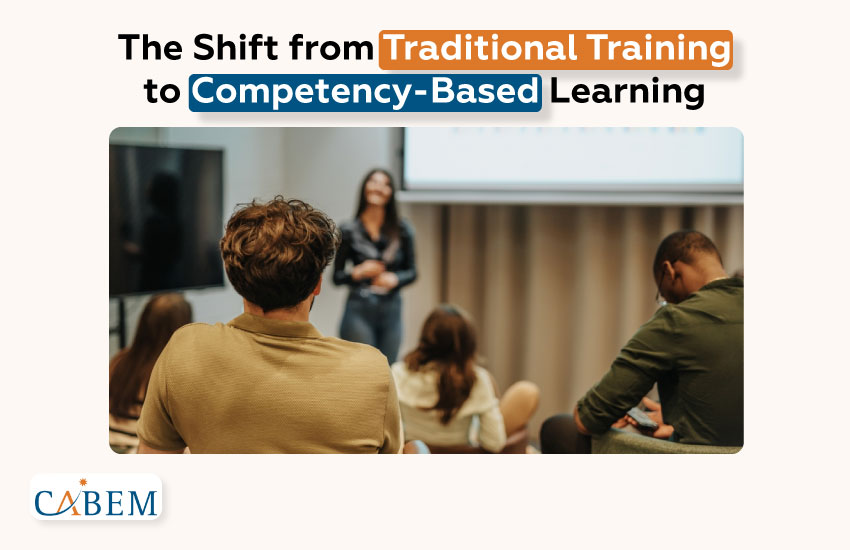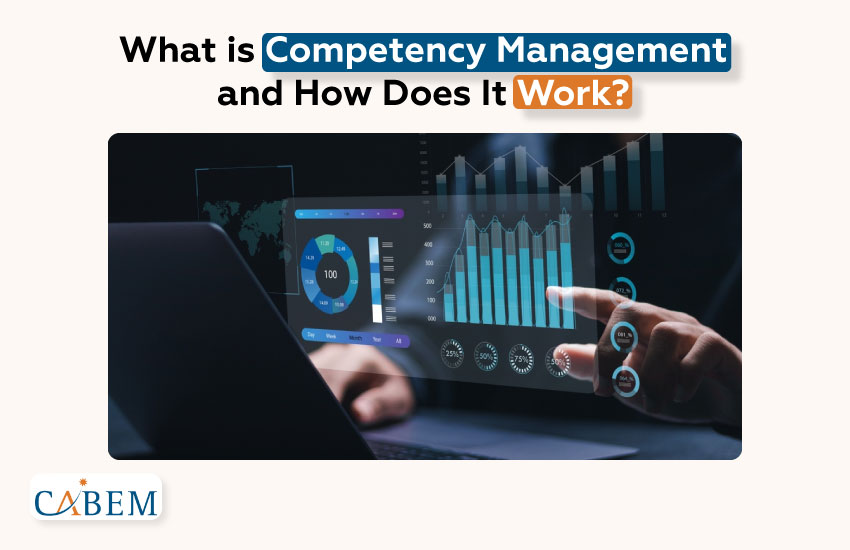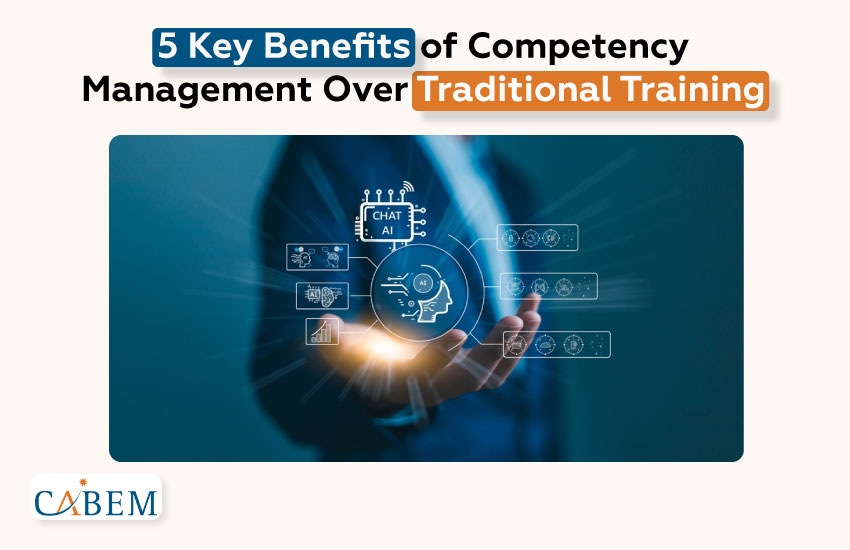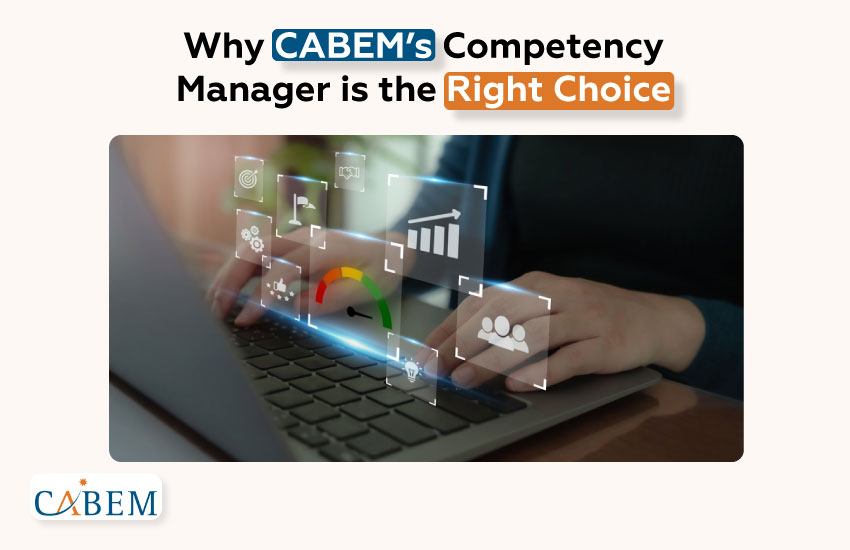Globalization poses a multitude of problems for businesses, especially in creating a modern workforce that is flexible, effective, and responsive. Did you know that 83% of organizations focus on improving workforce skills to stay ahead technologically? (Source: Deloitte). This figure makes it clear that employees require reconsideration in their development frameworks.
This article will examine why businesses are shifting away from traditional training methods and adopting competency-based management. We will explore the competency management process and how organizations can implement it to boost employee development, save time and money, increase compliance, and do it all with measurable, meaningful impact.
If your organization has not transitioned from traditional training approaches, you might want to rethink what prevents it from keeping pace with modern practices.

The Shift from Traditional Training to Competency-Based Learning
For decades, traditional training models have been the foundation for corporate learning and development. However, the trends are shifting now. Traditional methods no longer allow organizations to handle their dynamic, real-time needs. Here are the reasons why companies are transitioning to change.

The Limitations of Traditional Training
Traditional training focuses on broad, one-size-fits-all programs; it’s less likely to give workers the exact skills they need to be the best in their role. With the fast pace of technology change and industry standards, such outdated methods struggle to keep up.
Here’s why traditional training is no longer enough:
- Lack of Measurable Outcomes: Conventional training fails to provide concrete metrics for assessing employees’ application of the knowledge they’ve gained. This makes tracking real performance improvements within the business highly challenging.
- Repetitive & Inefficient Training: Most employees repeatedly complete the same training modules, even if they have already mastered the required skills. This duplication of effort is a waste of time and resources.
- High Costs & Administrative Burden: Traditional training programs require significant spending on resources, logistics, and administrative support, which results in inefficiencies and elevated expenses.
- Slow Skill Development: Traditional training programs take too much time, and employees may not acquire necessary skills at the pace of modern business.
- Increased Compliance Risks: Regulatory compliance and industry standards are constantly changing. Traditional training approaches may not keep pace with these developments, potentially exposing companies to the risk of non-compliance.
In short, traditional training methods have flaws and are no longer enough. We live in a fast-paced world, and businesses require a flexible, effective, and quantifiable method for workforce growth.

What is Competency Management and How Does It Work?
So, what exactly is competency management? On a fundamental level, competency management is a process through which you determine, develop, and monitor your workforce’s required skills and knowledge to perform at the highest level. It is much more targeted than traditional training and is primarily concerned with real-life skills that lead to job improvements.
Competency management systems help organizations establish the competencies for specific roles and rate employees’ performance against those criteria. They also make it easier to create targeted development plans, ensuring employees learn and hone specific skills that align with company goals. Competency-based systems are flexible and adaptive, allowing employees of varying abilities to advance at their own pace while providing assistance and encouragement.
Now you may ask yourself: Why is competency management such a game-changer over traditional training?
Fact: Are you ready to take your workforce development to the high-end? Learn how to revolutionize your training with competency-based learning management systems to enhance employee performance and generate results. So read our blog on the 6 Key Benefits of Competency-Based Learning Management Systems now and pave the way for the future of employee development!

5 Key Benefits of Competency Management Over Traditional Training
A competency management system can provide benefits that just won’t be gained through traditional training methods. In pursuing enhanced efficiency, compliance, and engagement, competency management systems offer organizations the strategies to simplify processes, guarantee development, and optimize results.
Here’s a closer look at the key advantages of transitioning to a competency-based model versus traditional training:
- Cost Reduction
- Improved Workforce Efficiency
- Compliance Automation
- Faster Employee Onboarding
- Higher Retention & Engagement
1. Cost Reduction
One of the leading advantages of competency management is cost reduction. Traditional training programs often require companies to pay for wide-ranging, one-size-fits-all training sessions that might not match an employee’s current skill set. These sessions may also be expensive, mainly if they involve using resources for repetitive training programs and unwanted products.
- Targeted Learning: As companies derive targeted competencies related to job execution, they can minimize training overlap by ensuring that employees receive only the training their job role requires. This saves time and money on topics they already know.
- Reduced Administrative Costs: Traditional training frameworks require manual tracking and scheduling, which are labor-intensive and costly. A competency management system automates Many of these tasks, minimizing administrative support.
- Example: According to a Deloitte report, Companies that use skills-based talent management have 30% lower turnover and 40% higher profitability.
Competency management systems help businesses reduce operational costs by eliminating redundancy and highlighting key metrics to focus on. This leads to better resource allocation.
2. Improved Workforce Efficiency
Competency management allows organizations to ensure the efficiency of their workforce by having the right skills at the right time. Conventional training leaves employees waiting long periods to review generalized training content that does not apply to their immediate job requirements.
- Faster Application of Skills: In competency-based learning, employees are trained specifically on role-based competencies, which they can apply immediately. This allows employees to contribute at a higher level much sooner than traditional training.
- Increased Productivity: When less time is wasted on non-targeted training, more time can be dedicated to valuable tasks. According to research from Harvard Business Review, firms with skills-based training experience a 20-25% increase in employee productivity. (Source: Harvard Business Review).
- Example: A case study from Motorola Solutions suggests that implementing a competency-based approach can lead to an 18% increase in team productivity in the first year of implementation.
Competency management ensures that each employee is capable, knowledgeable, and productive from day one, resulting in an efficient and productive workforce overall.
3. Compliance Automation
Compliance is vital in multiple industries, especially in fields like healthcare, manufacturing, and financial services. However, the dynamic nature of regulatory changes often makes traditional training methods outdated, causing compliance vulnerabilities. In contrast, competency management systems allow companies to automate the tracking of certifications, licenses, and other important compliance-related activities.
- Automated Tracking: Competency management systems allow organizations to track employees’ certifications and qualifications. This automation means no manual tracking is required, so there is less chance of human error.
- Real-Time Updates: The systems automate the renewal and tracking processes, ensuring employees are constantly updated on the latest industry regulations. Real-time insight into employee credentials helps ensure compliance never slips through the cracks.
- Reduced Risk of Non-Compliance: As businesses can keep track of compliance easily, they develop less risk of getting penalized and fined. A report conducted by PwC reveals that organizations implementing automated compliance solutions reduce their compliance-related penalties by 50%.
- Example: Harvard Medical’s move to a competency management system allowed it to automate employee training tracking at multiple locations. This ensured that every professional was compliant with the necessary healthcare regulations in real time, thus saving the organization hundreds of work hours of administration.
Automated tracking guarantees compliance and saves considerable time and effort that would otherwise be spent on laborious tracking, improving efficiency and accuracy.
4. Faster Employee Onboarding
Employee onboarding can be a long and tedious process, particularly when new hires must complete a series of general training sessions that do not precisely correlate to their job role. Competency management systems streamline the onboarding cycle, as new employees can become familiar with the skills required to meet role-specific competencies, helping them get up to speed far quicker.
- Customized Learning Paths: A competency-based approach enables personalized training paths tailored to each new employee’s job requirements. These paths allow employees to learn relevant skills faster and reduce their time to become productive team members.
- Clear Expectations: New hires understand precisely what skills are required of them, allowing them to devote time to developing those core skills that resonate with the company’s goals.
- Example: Mill Steel achieved a 40% reduction in time-to-productivity for new hires through a competency management system. The simplified onboarding process yielded both speed and increased overall employee performance quality.
Competency management systems enable organizations to concentrate on relevant skills and enable companies to get new hires to a productive state faster, thereby minimizing training time and costs.
5. Higher Retention & Engagement
A competency management system has many advantages, one of which is the increase in employee retention and engagement. Traditional training programs often feel disconnected from employees’ job positions, contributing to disengagement. On the other hand, competency management allows employees to clearly visualize a path towards career growth and skill development, resulting in stronger engagement and job satisfaction.
- Clear Career Development Paths: Employees who understand the connection between their development and real-world outcomes (i.e., upskilling for career progression) are more likely to remain with the company. According to a LinkedIn study, organizations with a robust employee development program have 34% higher retention rates.
- Increased Motivation: A competency management system allows employees to understand the avenues for growth specific to their job position. When employees know exactly which competencies are needed for progression, they are more motivated to work hard to get there.
- Example: Global CABEM customer SIL has reported a 26% increase in employee retention following the implementation of its competency management system. Professional development plan examples through SPAN: Today’s employees feel more engaged and want to invest in themselves.
In addition, when employees are equipped with tools that help them succeed and have a road map for further career progression, they are far more likely to stay within the company, decreasing turnover and raising company morale.

Why CABEM’s Competency Manager is the Right Choice
CABEM’s Competency Manager is an excellent choice for competency management for businesses looking to streamline and improve their workforce development processes.
Here’s why:
- Built for Regulated & High-Risk Industries
- Customizable to Fit Your Business Needs
- Automated Tracking & Reporting for Compliance
- Seamless Integration with Existing HR & Learning Systems
- Proven Results from Real Clients
1. Built for Regulated & High-Risk Industries
Competency Manager by CABEM was specially developed for industries that must adhere closely to compliance and regulatory standards, such as healthcare, manufacturing, public services, etc. It allows users to develop industry-specific skills and ensures that employees comply with industry requirements.
2. Customizable to Fit Your Business Needs
CABEM’s Competency Manager provides a flexible system that matches your organizational requirements. Since every business is unique, CABEM lets you customize the software to ensure it works for you in manufacturing, healthcare, or any other sector.
3. Automated Tracking & Reporting for Compliance
The system handles automation for tracking employee certifications, training completion, and skill enhancement. Businesses can ensure compliance without physically monitoring every detail. Generate audit-ready reports whenever you want, so you worry less.
4. Seamless Integration with Existing HR & Learning Systems
CABEM’s Competency Manager can be integrated into your existing HR and learning and management systems, so you can easily transition to more of a competency-based workforce development platform. Existing processes, therefore, are not disrupted, and implementation is seamless.
5. Proven Results from Real Clients
CABEM has proven successful in the field. Clients such as Harvard Medical, Motorola Solutions, and Mill Steel have already experienced positive changes in their organization’s employee development, compliance, and performance as a result of CABEM’s solutions. CABEM’s platform is trusted by industry-leading organizations worldwide, with over 925 active users worldwide.

Get a Demo of CABEM’s Competency Manager & Take the Next Step Today!
It’s already apparent why competency management is rapidly emerging as the gold standard for workforce development. With shifting demands and a competitive landscape, it’s time to embrace change and make the transition. CABEM is here to help if you think you are ready to revolutionize training and development! Our Competency Manager solution will empower you to streamline development, cut costs, and drive business performance to help organizations comply with regulations.
Want to learn more about taking your workforce development to the next level? Schedule a demo of CABEM’s competency manager today, and let us help you develop a skilled, productive, and compliant workforce. Start now—revolutionize your organization’s approach to employee training and development programs!
FAQs
1. What is the difference between traditional and competency-based training?
Traditional training usually covers broad concepts and some generalized competencies with no direct link to better job performance. In contrast, Competency-based training focuses on specific skills and knowledge that employees must master to succeed in their roles and make tracking results and ongoing progress easier.
2. What is the difference between training and competency?
Training is the act of providing knowledge or skills, usually in a general or one-size-fits-all manner. Competency is the level of knowledge or skill employees possess to carry out specific tasks in their job role.
3. What is the importance of implementing different ways of training and developing staff?
Utilizing a variety of training approaches, such as competency-based learning, allows businesses to build relevant skills and knowledge that are core to the organization’s objectives. It’s a more efficient training approach that lowers costs and positions employees to fulfill current and future business needs.
4. What is meant by competency management?
Competency management is the systematic process of identifying competencies, developing competencies, and tracking competencies necessary for employees to perform effectively. It is centered on quantifiable skills, behaviors, and knowledge that drive business success.

